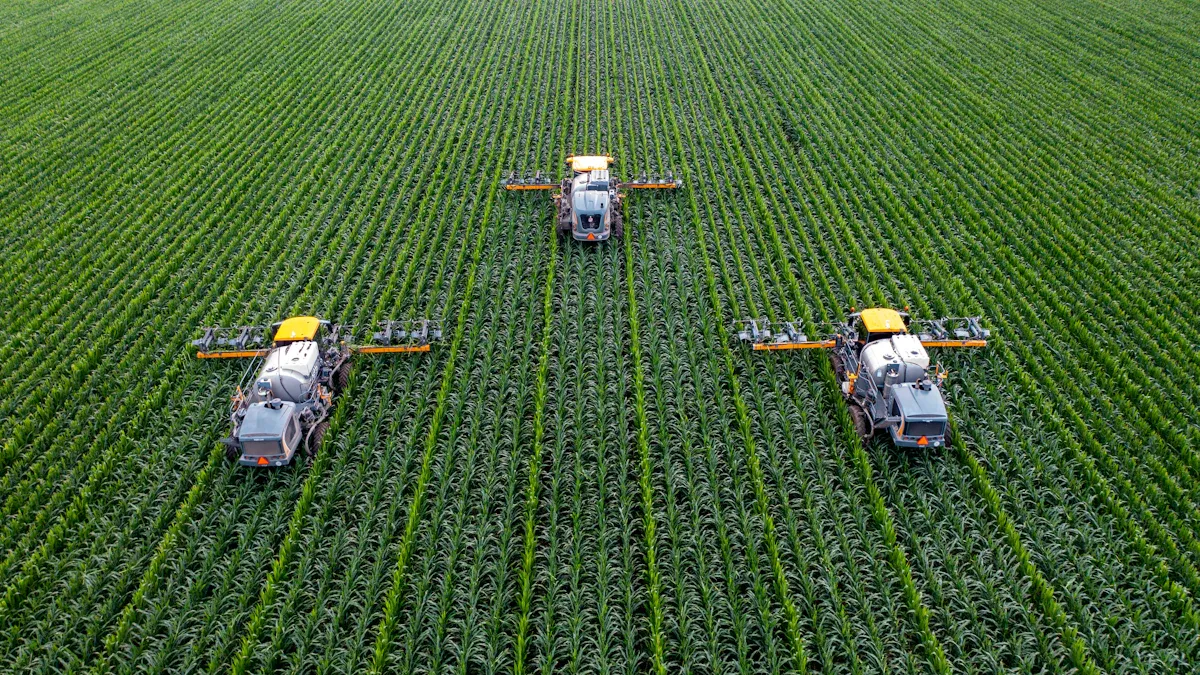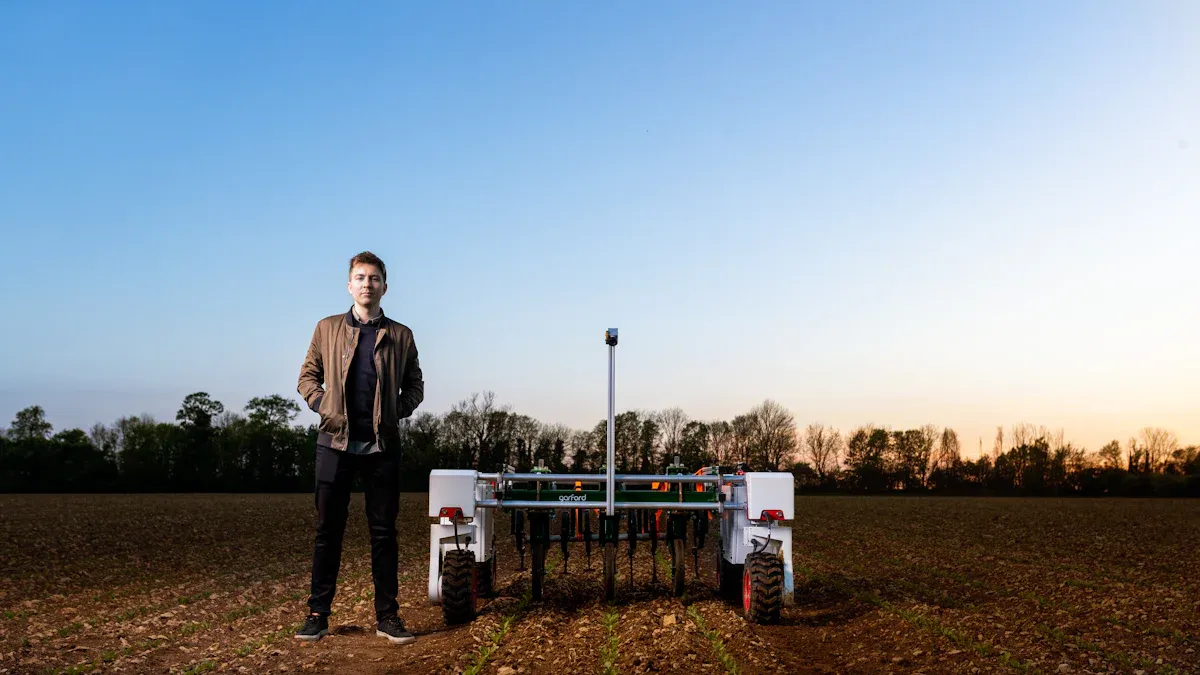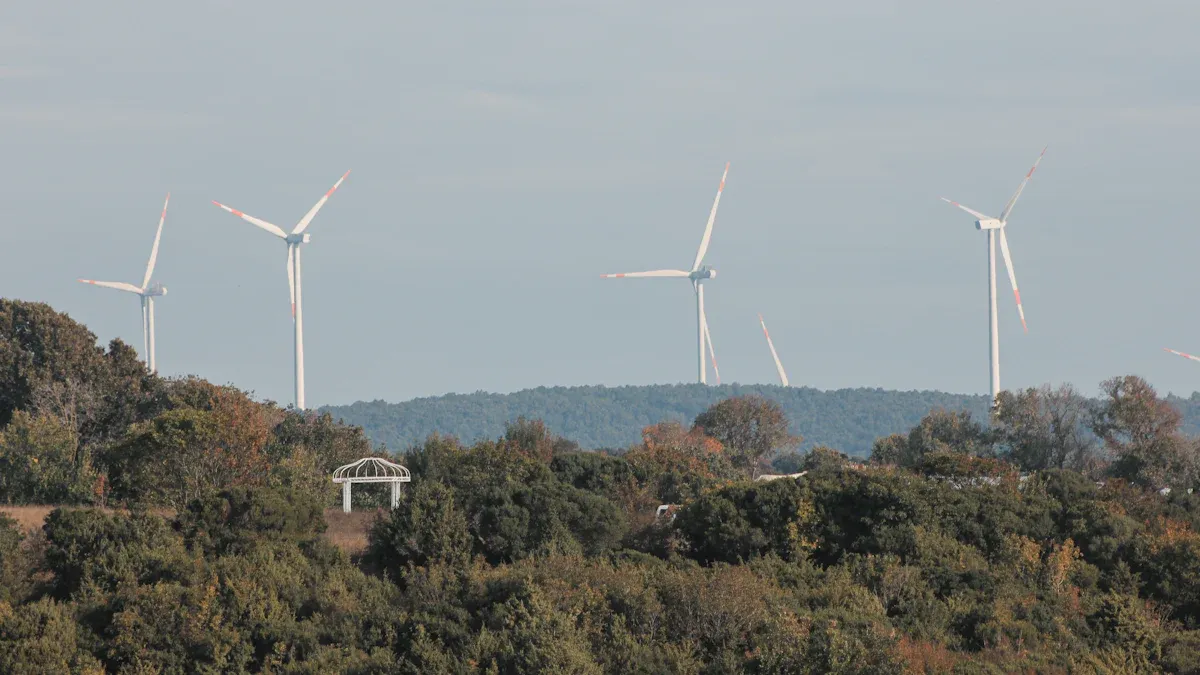The commercialization of high-precision and long-term stable agricultural CO2 sensors

Agricultural CO2 sensors play a crucial role in optimizing modern farming practices. These devices enable precise environmental monitoring, ensuring crops receive the ideal carbon dioxide levels for growth. High precision is essential for accurate measurements, while long-term stability ensures consistent performance over time. Studies have validated this importance:
Murata's CO2 sensors maintained accuracy within ± (30 + 2.5% of reading) after one year in a tomato greenhouse and two years in a rose greenhouse.
Reliability tests showed minimal drift after 2,000 hours in high-temperature and high-humidity conditions.
Commercialization of sensors for agriculture, such as the Murata NCP Series NTC Thermistors NCP02WF104D05RH, improves access to advanced tools, driving sustainability.
Key Takeaways
CO2 sensors help farmers check carbon dioxide levels for healthy crops.
Accurate and stable sensors need less recalibration, saving time and money.
Using CO2 sensors in farming helps use resources wisely and cuts waste.
Selling these sensors makes smart tools easier to get for farmers.
Teaching farmers how to use CO2 sensors helps them get the most benefits.
Applications of Agricultural CO2 Sensors

Greenhouse CO2 Management
Greenhouses rely on precise environmental monitoring to create optimal conditions for plant growth. Agricultural CO2 sensors play a pivotal role in maintaining the right carbon dioxide levels, which directly influence photosynthesis rates. By using these sensors, farmers can implement real-time monitoring to adjust CO2 concentrations dynamically, ensuring plants receive the necessary resources for healthy development.
In controlled environment agriculture, advanced CO2 sensors help reduce energy waste by optimizing ventilation and heating systems. For example, integrating these sensors into climate control systems allows for seamless adjustments, minimizing resource consumption while maximizing crop productivity. The global demand for such technologies is growing, with the CO2 gas sensor market projected to increase from $1.55 billion in 2025 to $3.21 billion by 2034, driven by the need for efficient air quality monitoring.
Soil Monitoring for Crop Health
Soil health is a critical factor in agricultural success. CO2 sensors provide valuable insights into soil gas concentrations, enabling farmers to detect imbalances that could affect crop growth. These sensors support precision fertilization by identifying areas with nutrient deficiencies, leading to improved soil management practices.
A study on coffee farming demonstrated the effectiveness of CO2 sensors in soil monitoring. By integrating IoT technology and machine learning models, researchers developed predictive tools for optimal irrigation and fertilization. This approach not only enhanced crop health but also addressed challenges associated with traditional soil testing methods. The findings highlighted the potential of real-time monitoring to revolutionize soil management practices, paving the way for more sustainable farming techniques.
Aspect | Details |
|---|---|
Research Focus | Use of CO2 sensors in soil monitoring for coffee farming. |
Technology Used | Integration of IoT technology and machine learning models (RNNs) for real-time data collection. |
Benefits | Improved soil management practices leading to enhanced crop health. |
Key Findings | Predictive models for optimal irrigation and fertilization based on soil nutrient data analysis. |
Challenges Addressed | Limitations of traditional soil testing and the need for tailored management practices. |
Future Directions | Exploration of RNN-IoT approaches and their comparison with existing methods. |
Optimizing Crop Yield and Quality
Agricultural CO2 sensors contribute significantly to optimizing crop yield and quality. These sensors provide accurate CO2 measurements, which are essential for maintaining ideal growing conditions. High-precision sensors reduce the need for frequent recalibration, ensuring consistent performance over time.
Farmers can integrate these sensors into existing systems to monitor environmental factors such as temperature, humidity, and CO2 levels. This integration enables them to make data-driven decisions, improving resource efficiency and reducing waste. For instance, robust sensor designs allow for seamless compatibility with climate control systems, enhancing overall productivity.
Feature | Description |
|---|---|
Accuracy and Reliability | Provides precise CO2 measurements essential for optimal plant growth. |
Minimal Calibration Requirements | Designed to compensate for drift, reducing the need for frequent recalibration. |
Easy System Integration | Robust design allows for seamless integration into existing climate control systems. |
The commercialization of agricultural CO2 sensors has made these technologies more accessible to farmers worldwide. As a result, they can adopt advanced tools to improve crop quality, enhance sustainability, and meet the growing demand for food production.
Technological Features of High-Precision CO2 Sensors
High precision for accurate measurements
High precision is a critical feature of modern CO2 sensors, ensuring accurate measurements in agricultural environments. Precision allows farmers to monitor CO2 levels effectively, enabling them to make data-driven decisions for crop management. NASA's enhanced CO2 microsensor demonstrates how advanced technology achieves this. By incorporating a layer of nanocrystalline tin oxide, the sensor improves electron availability for CO2 detection. This innovation reduces power consumption by allowing the sensor to operate at lower temperatures while maintaining high precision.
Modern sensors also utilize advanced features to enhance accuracy. For instance:
Automatic calibration eliminates the need for manual adjustments, saving time and effort.
Dual wavelength NDIR technology uses a measurement and reference wavelength to improve precision.
Robust designs ensure consistent performance even in challenging agricultural conditions.
These features make high-precision CO2 sensors indispensable for optimizing crop yield and quality.
Long-term stability in agricultural environments
Long-term stability is essential for CO2 sensors used in agriculture. Sensors must perform reliably over extended periods without frequent recalibration. NDIR CO2 sensors excel in this regard. They are engineered to minimize drift, ensuring consistent accuracy throughout their lifespan.
A comparison of capacitive and resistive humidity sensors highlights the importance of stability:
Feature | Capacitive Humidity Sensors | Resistive Humidity Sensors |
|---|---|---|
Reliability & Stability | Highly reliable with excellent long-term stability | Less stable over time, prone to drift |
Lifespan | Longer, with minimal recalibration | Shorter, requiring frequent recalibration |
In agricultural environments, where conditions like humidity and temperature fluctuate, long-term stability ensures uninterrupted monitoring. This reliability reduces maintenance costs and enhances resource efficiency, making these sensors a valuable investment for farmers.
NDIR technology and its advantages
Non-Dispersive Infrared (NDIR) technology is a cornerstone of modern CO2 sensors. It offers several advantages over alternative methods, making it ideal for agricultural applications. NDIR sensors measure CO2 levels by analyzing the absorption of infrared light at specific wavelengths. This approach ensures high accuracy and reliability.
Key benefits of NDIR technology include:
Cost-effectiveness: The SenseAir K30 sensor, for example, provides accuracy comparable to more expensive CRDS sensors while being affordable.
Durability: NDIR sensors resist humidity and vibration, ensuring long-term storage and operation in harsh environments.
Portability: Compact designs allow for easy integration into various agricultural systems.
These advantages make NDIR-based CO2 sensors a preferred choice for precision agriculture. By combining high precision, long-term stability, and advanced technology, these sensors empower farmers to optimize their practices and achieve sustainable farming goals.
Benefits of Commercializing Sensors for Agriculture
Enhancing resource efficiency
Commercializing sensors for agriculture has revolutionized resource management in farming. These sensors enable farmers to monitor environmental factors such as soil moisture, temperature, and CO2 levels with precision. Real-time monitoring allows for timely adjustments, reducing water and fertilizer waste. Precision fertilization becomes more effective as sensors identify nutrient deficiencies and guide targeted applications.
Digital tools integrated with sensors streamline resource allocation. For example, decision support systems combine weather data, soil conditions, and crop requirements to optimize irrigation schedules. This approach minimizes overwatering and ensures crops receive adequate hydration. Remote sensing technologies, including satellite imagery and drone-captured multispectral data, further enhance resource efficiency by detecting issues like nutrient imbalances early.
Tip: Farmers can achieve significant savings by adopting sensor-based systems that reduce unnecessary resource consumption while improving productivity.
Reducing costs for farmers
The commercialization of agricultural CO2 sensors has made advanced technologies more accessible and affordable. Farmers benefit from reduced operational costs as sensors improve efficiency and reliability. Advancements in sensor technology have led to user-friendly designs that require minimal maintenance, lowering long-term expenses.
Several factors contribute to cost reductions:
Integration of IoT and Big Data Analytics: These technologies optimize resource use, reducing waste and increasing productivity.
Growth of Smart Farming Practices: Sensors enhance farm management by automating processes like irrigation and fertilization.
Improved Sensor Reliability: Modern sensors are designed to withstand harsh agricultural environments, reducing repair and replacement costs.
Farmers adopting sensors for agriculture experience financial benefits through better resource management and reduced labor requirements. These savings make sensor-based farming an attractive option for small-scale and large-scale operations alike.
Improving crop quality and sustainability
Sensors play a crucial role in improving crop quality and promoting sustainable agricultural practices. By providing accurate environmental monitoring, they help farmers maintain optimal growing conditions. Agricultural CO2 sensors, for instance, ensure plants receive the right amount of CO2 for photosynthesis, enhancing growth and yield.
Ground-based sensors deliver real-time data on soil moisture and temperature, enabling precision fertilization and irrigation. This targeted approach reduces the risk of over-fertilization, which can harm soil health and water quality. Decision support systems integrate sensor data with external factors like weather forecasts, guiding farmers in sustainable resource allocation.
Remote sensing technologies also contribute to sustainability. Satellite imagery and drone-captured data detect nutrient deficiencies and pest infestations early, allowing farmers to address issues before they escalate. These tools reduce chemical usage and promote environmentally friendly farming practices.
Note: Transitioning to sensor-based systems supports sustainable farming by reducing environmental impact and improving crop quality.
Challenges in Commercializing Agricultural CO2 Sensors
High costs and affordability issues
The high cost of advanced agricultural CO2 sensors remains a significant barrier to widespread adoption. Many sophisticated models are priced beyond the reach of small-scale farmers and residential users. This limits their accessibility and prevents broader market penetration. Reducing the cost of these sensors while maintaining their accuracy and functionality is essential to address this challenge.
Several factors contribute to the high costs. Advanced sensors often incorporate cutting-edge technologies like NDIR, which require specialized materials and manufacturing processes. Additionally, the integration of features such as real-time monitoring and environmental monitoring capabilities adds to production expenses. To make sensors for agriculture more affordable, manufacturers must explore cost-effective production methods and economies of scale.
Note: Lowering costs without compromising quality will enable more farmers to adopt these technologies, fostering sustainable farming practices.
Adoption barriers and lack of awareness
Adoption barriers and limited awareness further hinder the commercialization of CO2 sensors. Many farmers remain unaware of the benefits these sensors offer, such as optimizing crop growth and improving resource efficiency. This lack of awareness often results in hesitation to invest in new technologies.
Farmers may also face challenges in integrating sensors into their existing systems. Compatibility issues, technical complexities, and the perceived difficulty of using advanced tools discourage adoption. Manufacturers and agricultural organizations must work together to simplify sensor designs and provide clear guidance on their use. Demonstrating the tangible benefits of controlled environment agriculture through case studies and success stories can also help overcome these barriers.
The need for farmer education and training
Effective utilization of agricultural CO2 sensors requires proper education and training. Many farmers lack the technical knowledge needed to operate and interpret data from these devices. Extension services, workshops, and online resources play a crucial role in closing this knowledge gap.
Training programs should focus on practical applications, such as using sensors for real-time monitoring and environmental monitoring. These programs can teach farmers how to optimize CO2 levels for controlled environment agriculture, improving crop yield and sustainability. Expanding Extension services and providing technical support will further encourage adoption.
Tip: Investing in farmer education ensures that advanced technologies are used effectively, maximizing their potential benefits.
Real-World Success Stories

Greenhouse tomato production with CO2 sensors
Greenhouse tomato farming has seen remarkable improvements with the adoption of agricultural CO2 sensors. These sensors enable precise environmental monitoring, ensuring optimal CO2 levels for photosynthesis. Farmers can now maintain controlled environment agriculture with greater efficiency, leading to healthier plants and higher yields.
In one case, a tomato greenhouse in the Netherlands integrated CO2 sensors into its climate control system. The sensors provided real-time data on CO2 concentrations, allowing the system to adjust ventilation and heating automatically. This approach reduced energy consumption while maintaining ideal growing conditions. As a result, the farm reported a 20% increase in tomato yield and a significant reduction in operational costs.
The success of CO2 sensors in greenhouse tomato production highlights their potential to transform controlled environment agriculture. By optimizing CO2 levels, farmers can achieve better crop quality and sustainability.
Regional advancements in precision agriculture
Precision agriculture has advanced significantly across different regions due to the adoption of sensors for agriculture. These technologies have enabled farmers to monitor environmental factors like soil moisture, temperature, and CO2 levels with unprecedented accuracy.
Region | Adoption Rate | Key Factors |
|---|---|---|
Developed Countries | High | Advanced technological infrastructure, strong government support |
Developing Countries | Gradual Increase | Growing awareness, decreasing cost of technology |
Crop-Specific | Varies | More common in large-scale crops (corn, soybeans, wheat); increasing in fruits and vegetables due to quality and yield needs. |
In developed countries, strong government support and advanced infrastructure have driven high adoption rates. In contrast, developing countries are experiencing a gradual increase as technology becomes more affordable. Crop-specific adoption also varies, with large-scale crops like corn and soybeans leading the way. However, fruits and vegetables are catching up due to the demand for higher quality and yield.
These regional advancements demonstrate how sensors for agriculture are shaping the future of farming worldwide.
Insights from early adopters
Early adopters of agricultural CO2 sensors have shared valuable insights into their benefits and challenges. Many report significant improvements in crop yield and resource efficiency. For example, a farmer in California integrated CO2 sensors into their vineyard's irrigation system. The sensors provided real-time environmental monitoring, enabling precise water management. This approach reduced water usage by 30% while improving grape quality.
However, early adopters also highlight challenges such as high initial costs and the need for technical training. Despite these hurdles, they emphasize the long-term benefits of adopting sensor-based systems. Their experiences underscore the importance of education and support in promoting the widespread use of these technologies.
By learning from early adopters, the agricultural industry can better address barriers and accelerate the adoption of advanced sensors.
Agricultural CO2 sensors are revolutionizing farming by enabling precise environmental monitoring and resource optimization. Their transformative potential is evident in projections showing that efficient irrigation practices could cut energy demand by up to 50%, while CO2 emissions may decrease by 90%. These advancements align with the growing adoption of precision agriculture technologies, which are expected to generate $18 billion in revenues by 2024.
The commercialization of sensors for agriculture has accelerated the adoption of sustainable practices. The global precision farming market, valued at $16.35 billion, is growing at a 13.1% annual rate. This growth reflects increasing government support and consumer demand for eco-friendly farming solutions. Techniques like cover cropping and no-till farming are becoming mainstream, driven by these trends.
The future of precision agriculture looks promising with the integration of IoT devices and satellite connectivity. These technologies enhance data collection on soil, moisture, and weather, empowering farmers to optimize crop production. By embracing advanced sensor technologies, the agricultural sector can achieve sustainability while meeting the rising demand for food.
What are agricultural CO2 sensors used for?
Agricultural CO2 sensors monitor carbon dioxide levels in farming environments. They help optimize greenhouse conditions, improve soil health, and enhance crop yield. These sensors provide real-time data, enabling farmers to make informed decisions for better resource management and sustainable farming practices.
How do CO2 sensors improve crop yield?
CO2 sensors ensure plants receive optimal carbon dioxide levels for photosynthesis. By maintaining ideal growing conditions, these sensors boost plant growth and productivity. Farmers can also integrate them into climate control systems to adjust ventilation and irrigation, further enhancing crop yield and quality.
Why is long-term stability important in CO2 sensors?
Long-term stability ensures sensors provide accurate measurements over extended periods without frequent recalibration. This reliability reduces maintenance costs and ensures uninterrupted monitoring in fluctuating agricultural environments. Stable sensors are essential for consistent performance in precision farming.
What is NDIR technology in CO2 sensors?
NDIR (Non-Dispersive Infrared) technology measures CO2 levels by analyzing infrared light absorption. It offers high accuracy, durability, and cost-effectiveness. NDIR sensors resist harsh conditions like humidity and temperature changes, making them ideal for agricultural applications.
How does sensor commercialization benefit farmers?
Commercialization makes advanced sensors more accessible and affordable. Farmers gain access to tools that improve resource efficiency, reduce costs, and enhance crop quality. By adopting these technologies, they can achieve sustainable farming practices and meet increasing food production demands.
See Also
Simple Guide to Integrating the SN74LVC4245APW Sensor
Three Key Transformations of Industrial Automation by ATIC83E2
Three Major Impacts of XCF01SVOG20C on Automation
Utilizing ADXL357BEZ for Motion Sensors and Stability Solutions
CALL US DIRECTLY
(+86)755-82724686
RM2508,BlockA,JiaheHuaqiangBuilding,ShenNanMiddleRd,Futian District,Shenzhen,518031,CN
www.keepboomingtech.com sales@keepboomingtech.com
